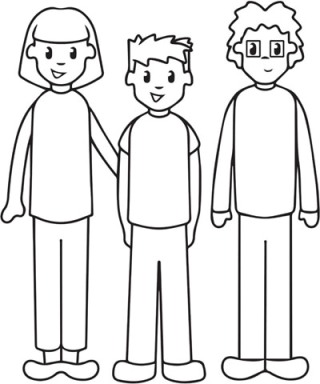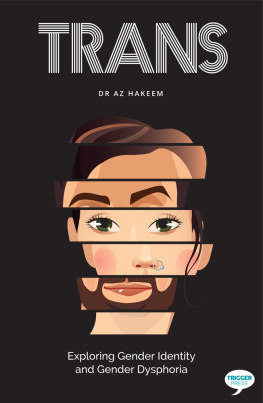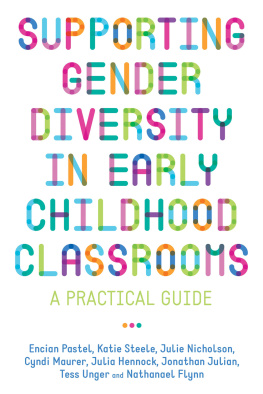
CAN I TELL
YOU ABOUT
GENDER
DIVERSITY?
A guide for friends, family
and professionals
CJ ATKINSON
Illustrated by Olly Pike

Jessica Kingsley Publishers
London and Philadelphia
CONTENTS

M y name is Kit and Im 12 years old. I live in a house with my mum and dad, and our dog, Pickle.
When I was born, the doctors told my mum and dad that they had a baby girl, and so for the first few years of my life thats how my parents raised me. This is called being assigned female at birth. I wasnt ever very happy that way. I didnt like playing with dolls, or wearing dresses, and I hated having long hair. My mum remembers that when I was three I asked everybody to call me Christopher. Any time somebody called me a girl, I would say no, boy.
This got really hard when I started school. Thats when I would get into trouble for sitting with the boys, or not doing girl things. My mum and dad had always just let me play however I wanted, and now that wasnt really allowed as much.
One time in my English class, I wrote a story about a girl who wanted to grow up to be a prince and not a princess. She didnt want to wear fancy dresses or go to a ball, but instead wanted to grow up to have a suit of armour, and a horse, and for everyone to call her Sir. Everybody told her that she had to be a princess and there was nothing she could do about it. She was so sad, and when I had to read the story out in class I started to cry because I knew exactly what the princess was going through. I knew because all I wanted was to be a prince, but it was like everybody was telling me that I had to want to grow up to be a princess.
That was when my teacher asked if everything was okay at home, or if I needed some help or somebody to talk to. I told him all about how it felt on the inside, how girl things just made me feel confused and worried but boy things made me happy. How all I really wanted to do was to cut my hair and have people realise that I was a boy. The teacher asked my parents to come in and have a talk, and I got to tell them what was happening in my head.
My mum and dad were a little bit surprised but they hugged me really hard and said that they would do anything to help me because they only cared about me being happy, and the minute they said that I stopped feeling worried and sad it was like I could actually take a really deep breath of air!

Y ou see, I have a different gender identity than I was assigned at birth. Another name for this is called being transgender. For some people, this is like feeling as though you are born in the wrong body, or like the body that you have doesnt match how you feel in your head. This can happen to people who were assigned female at birth, male at birth, or those who are intersex.
Some people are born with body chemistry that isnt typical for a girl or a boy. This happens with about one in every 2000 people that are born, and is called being intersex. Some intersex people identify as transgender, and some dont.
Other people never have any confusion about their gender from when they are born. They feel like how the world sees them and how they see themselves are the same. This is called being cisgender.
Not everybody realises these things at the same time in their lives. I knew my whole life that there was something that wasnt right, and I didnt want to be called a girl. Sometimes it takes until a person is going through puberty, when their bodies are changing and that when they realise that things arent feeling right for them at all. Other people dont realise until theyre an adult, or until a little bit later in their lives. This doesnt mean that theyre any less trans or that they are going through any less, its just that some people go through different things at different times.
Some trans people are binary they feel like they were born in the wrong body, and that they are the opposite gender. Non-binary people dont feel like this at all. They may not feel anything like male or female, or they might feel every part of male and female. They may have different identities, or it might change. Some non-binary people identify as transgender and some dont. It can be confusing, but it helps if you start to think about gender as different from, say, a light switch, and a bit more like a spectrum. Instead of people only being able to be a boy or a girl, some people might fall anywhere in between. When we talk about somebody being only a boy or a girl, we call this being binary.
When it comes to talking to people who identify differently, its really important not to make assumptions, and to listen to what the person tells you about who they are. After all, they know themselves better than you do! Thats the great thing about a spectrum you can be at either end of it, or you can fall somewhere in the middle, and nobody has to feel left out.
The main thing to remember about a spectrum is that its like a sliding scale, but nobody is better than anybody else. If somebody is trans, then they are trans. Theres no such thing in the world as not being trans enough, and its not for anybody else to decide who or what you are. If a person chooses not to medically transition, that doesnt make them less trans. What a person chooses to do with their own body doesnt make them more or less of a person!

O ne of the ways that people get confused about trans people is that they think it has anything to do with being gay. Another word for gay is homosexual, and that doesnt have anything to do with your gender but instead has to do with the people that you are attracted to.
Homosexuals are people who like people who are the same gender that they are. Women who like women are called lesbians, and men who like men are called gay. These words are scary to some people, which is silly. Bisexual and pansexual people are attracted to any gender. Asexual people simply dont experience sexual attraction to people.
Just like gender identity, sexual orientation can be a bit of a spectrum. Some people might see themselves as 100% heterosexual or 100% homosexual. Other people might change as they get older, or depending on the people that they meet in their lives.
Just like cisgender people, trans people can be straight, or gay, or bisexual, or asexual. Sometimes this might change as people go through transition and become more comfortable with themselves. Thats the other great thing about a spectrum it might not always be the same every day of your life. This doesnt have to be scary at all.

W hen you start to live as the gender you identify as, this is called transitioning. There are some different kinds of transition.
When I asked people to start calling me Kit, and using he/him pronouns, this is called social transition. It means that everybody in my life knows who I am, and treats me the way theyd treat any other boy. I wear boys clothes, and I have a boys hair cut, and people refer to me as he/him. This is a big step for trans people, as it can be the first time in our lives that the world really acknowledges us for who we are.
Next page














